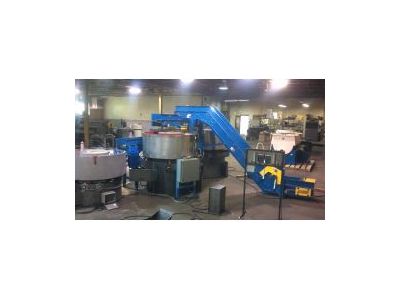Breaking or Throwing Belts on a Vibratory Finisher

Tags: tub finisher
There are currently two styles of powering a vibratory bowl or tub finisher. One style is to power the bowl or tub with a direct-drive (integral) motor, located on or in the vibrating bowl or tub. The other is to belt drive a bearing supported drive shaft (located in the bowl or tub) from the non-vibrating base weldment of the machine. When operating a belt driven machine, it is not uncommon to experience issues of belts throwing off the pulleys, or in some instances, snapping. There certain conditions that usually cause these types of issues, all of which can be checked for and corrected, to ensure long belt life on the equipment.
The first main cause of these conditions is pulley alignment. There are pulleys located on the bowl or tub drive-shaft (this is referred to as the “driven-pulley”) and on the electric motor powering the machine (this is the “driving-pulley”). In many cases, there is also an “idler-pulley," usually mounted to a belt tensioner, to remove any slack that might be present in the belt. During operation, these pulleys need to be within accepted alignment with regards to one another to prevent a belt from throwing or breaking during operation. On most machines, there is usually room to adjust the pulleys' location on the shafts they mount to, to bring them into alignment if they are found to be misaligned. When checking for pulley alignment, I have found it to be easy and convenient to use the floor as a reference point. Simply measure from the floor to the bottom edge of the pulleys, and write those dimensions down. Review the dimensions, and you will see if there is any misalignment present. Now adjustments can be made, to bring those pulleys into alignment, which solved the problem. It is important to keep in mind that these measurements should be taken when the machine has a working load of media and parts in the bowl or tub. Media levels, varying parts loads, broken springs, etc. can all have an effect on these measurements and need to be taken into consideration before obtaining the measurements. In addition, it is important to remember that belt driven machines can and do handle slight pulley misalignment. This is typically less than ½ of 1 degree.
Another cause for belts throwing or snapping on these machines can be proper belt tension. Most belt driven machines utilize some type of tensioning device. Most of the time, an idler pulley is mounted to this tensioner. This idler pulley/tensioner combination takes up any slack in the belt, while keeping a more constant tension applied to the belt, during the bowl or tubs operation. Belt tensioners are more common on vibratory bowls than they are on tubs. Belts can handle quite a bit of tension, due to their durable construction. As a general rule, a belt is properly tensioned when there is less than 1” of overall displacement on the non-tensioned side of the belt also known as the slack side. Any more deflection greater than this means there is too much slack in the belt and can cause a belt to throw off of a pulley. On the other hand, belts can be tensioned too tight. When this occurs, excessive vibration is typically noticed in the non-vibrating base of the machine. This can cause machines to “walk” during operation or shutdown or cause items mounted to the base of the machine to shake excessively. This problem can be fixed by simply relieving the amount of tension applied to the belt at the tensioner.
Although most belt issues experienced on vibratory finishing machines generally fall into the previous two categories, there are other variables that can affect belt life and performance. Keeping the belts free from oil and water/soap exposure is important. Certain soaps and finishing compounds can attack the composition of the belt, causing the belt to prematurely fail. This is also common with many of the lubricating oils used on these machines to lubricate the bearings. Leaks in the plumbing, allowing for these oils to come in contact with the belts, can have the same effect. When possible, always take steps to correct these instances, to ensure long belt life.
Although there are more moving parts involved in a belt-drive style vibratory finisher, the long term maintenance costs generally are considerably lower than on machines with a direct-drive motor system. Belts and pulleys are generally inexpensive and widely available from local vendors. Belt drive vibratory machines have been in service in the industrial world for nearly half a century, and will continue to be a mainstay in this sector for years to come.


